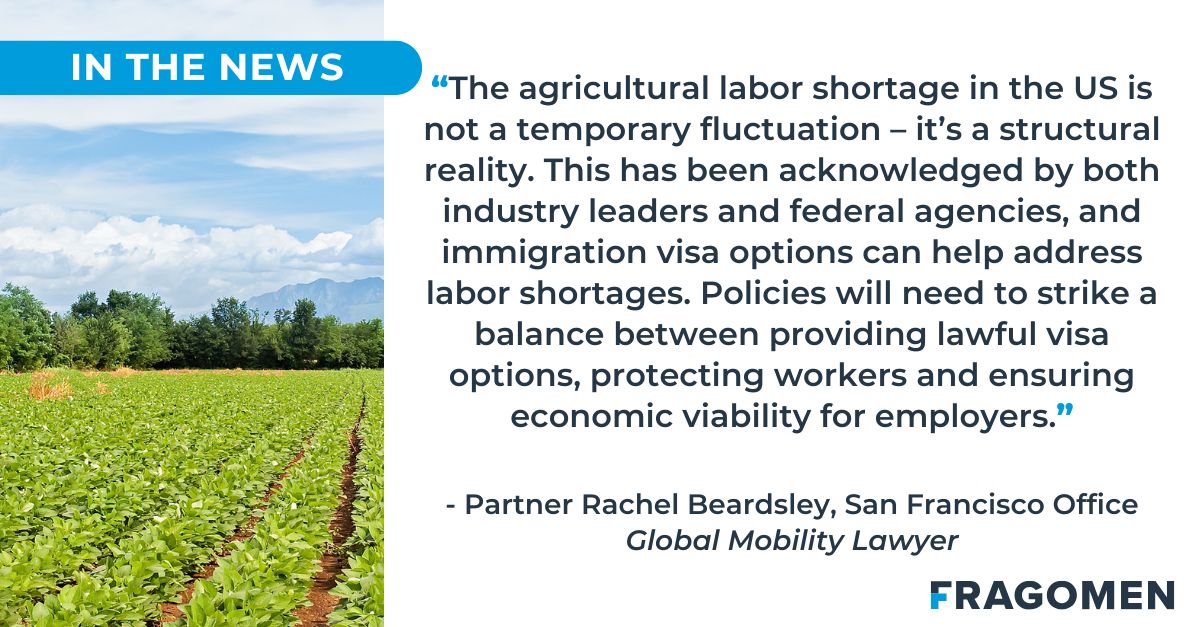Global Mobility Lawyer: DOL Flags Immigration Crackdown as Risk to Food Supply – Fragomen

Report on US Immigration Policy’s Impact on Agricultural Sustainability and Food Security
Executive Summary
A recent analysis highlights a critical linkage between United States immigration enforcement policies and the stability of the nation’s food supply. The U.S. Department of Labor (DOL) has acknowledged that stringent immigration enforcement may precipitate significant agricultural workforce shortages. This development poses a direct challenge to the achievement of key Sustainable Development Goals (SDGs), particularly those concerning food security, sustainable agriculture, and economic stability.
- Evolving immigration policies are a primary determinant of agricultural workforce stability.
- Persistent labor shortages threaten to disrupt food production and escalate consumer prices.
- The situation presents substantial risks to the advancement of SDG 2 (Zero Hunger) and SDG 8 (Decent Work and Economic Growth).
- Legal immigration frameworks, such as the H-2A visa program, are identified as crucial mechanisms for mitigating these risks and sustaining a skilled agricultural workforce.
Analysis of Impact on SDG 2: Zero Hunger
The connection between immigration policy and food security is direct and consequential. A reduction in the available agricultural labor force, driven by stricter enforcement, directly undermines the objectives of SDG 2, which aims to end hunger, achieve food security, improve nutrition, and promote sustainable agriculture.
- Stricter immigration enforcement diminishes the pool of available and experienced agricultural workers.
- The resulting labor shortages create critical vulnerabilities in the food supply chain, affecting production and harvesting capacity.
- These disruptions threaten the stability and affordability of the national food supply.
- Such outcomes directly contravene the core targets of SDG 2 by jeopardizing food security and the viability of sustainable agricultural practices.
Implications for SDG 8: Decent Work and Economic Growth
The agricultural sector’s reliance on immigrant labor is a cornerstone of its economic productivity and contribution to national growth. The current labor challenges, as noted by legal experts like Partner Rachel Beardsley, are long-standing and have profound implications for SDG 8, which promotes inclusive and sustainable economic growth, full and productive employment, and decent work for all.
- The stability of the agricultural sector is integral to sustained national economic growth.
- Chronic labor shortages, exacerbated by immigration policy, impede sectoral productivity and economic potential.
- Regulated visa strategies, including the H-2A program, are essential for providing a legal and orderly channel for temporary agricultural labor, thereby supporting the “decent work” component of SDG 8.
- Failure to address the agricultural workforce gap poses a risk of economic contraction within a vital industry, undermining broader economic objectives.
Conclusion and Policy Recommendations
The findings indicate that U.S. immigration policy is inextricably linked to the nation’s capacity to meet fundamental goals of food security and economic stability, which are in alignment with the global Sustainable Development Goals. To address the identified risks, a strategic approach is necessary.
- Develop and implement immigration policies that recognize the essential contribution of foreign labor to the agricultural sector, thereby supporting SDG 2.
- Strengthen and streamline legal visa pathways, specifically the H-2A program, to ensure a reliable, skilled, and legally protected workforce, in line with the principles of SDG 8.
- Promote greater policy coherence between the Department of Labor and immigration authorities to create a regulatory environment that supports both national food security and sustainable economic growth.
Analysis of Sustainable Development Goals (SDGs) in the Article
1. Relevant Sustainable Development Goals (SDGs)
-
SDG 2: Zero Hunger
This goal is directly addressed through the article’s central theme, which is the risk that immigration policies pose to the “food supply.” The text explicitly states that “tighter immigration enforcement could […] affect food production and prices,” linking labor availability directly to food security and accessibility.
-
SDG 8: Decent Work and Economic Growth
The article focuses on the “US agricultural workforce” and “labor shortages.” It discusses the need to “sustain a skilled US agricultural workforce” through mechanisms like H-2A visas. This connects to SDG 8’s aim to promote sustained, inclusive, and sustainable economic growth, full and productive employment, and decent work for all, particularly within a key economic sector like agriculture.
-
SDG 10: Reduced Inequalities
This goal is relevant through its focus on migration policies. The article discusses “evolving immigration policies,” “tighter immigration enforcement,” and “H-2A visa strategies.” These are all elements of national policies that govern the mobility and rights of migrant workers, which is a key concern of SDG 10, particularly Target 10.7 on orderly, safe, and responsible migration.
2. Specific SDG Targets
-
Target 2.1: By 2030, end hunger and ensure access by all people, in particular the poor and people in vulnerable situations, including infants, to safe, nutritious and sufficient food all year round.
- The article connects to this target by highlighting a direct “risk to food supply” and potential impacts on “food production and prices.” A disruption in the agricultural workforce threatens the availability and affordability of sufficient food.
-
Target 8.5: By 2030, achieve full and productive employment and decent work for all women and men, including for young people and persons with disabilities, and equal pay for work of equal value.
- The discussion of “agricultural labor shortages” and the need to “sustain a skilled US agricultural workforce” points to this target. The article implies that without a stable workforce, the agricultural sector cannot maintain productive employment, which is essential for economic stability.
-
Target 8.8: Protect labour rights and promote safe and secure working environments for all workers, including migrant workers, in particular women migrants, and those in precarious employment.
- The mention of “H-2A visa strategies” directly relates to this target. The H-2A program is a legal framework designed to govern the employment of migrant agricultural workers. The effective and fair implementation of such visa programs is crucial for protecting the labor rights of migrant workers.
-
Target 10.7: Facilitate orderly, safe, regular and responsible migration and mobility of people, including through the implementation of planned and well-managed migration policies.
- The article’s core subject is the impact of “evolving immigration policies” and “tighter immigration enforcement” on a critical sector. It implicitly argues for well-managed policies (like “H-2A visa strategies”) to ensure the mobility of workers needed to prevent economic disruption, directly aligning with this target.
3. Mentioned or Implied Indicators
- Indicator for Target 2.1: The stability of food production and prices. The article implies these are key metrics by stating that immigration enforcement could “affect food production and prices.” Measuring fluctuations in agricultural output and food costs would be an indicator of progress.
- Indicator for Target 8.5: The prevalence of agricultural labor shortages. The article explicitly identifies “workforce shortages” and “agricultural labor shortages” as the central problem. The rate of unfilled jobs in the agricultural sector serves as a direct indicator.
- Indicator for Target 10.7: The number of workers admitted through specific migration schemes. The reference to “H-2A visa strategies” implies that the number of visas issued or the effectiveness of this program is a measurable indicator of how migration policy is being used to address labor needs.
4. Summary Table: SDGs, Targets, and Indicators
| SDGs | Targets | Indicators |
|---|---|---|
| SDG 2: Zero Hunger | 2.1: Ensure access to safe, nutritious and sufficient food all year round. | Stability of food production levels and food prices. |
| SDG 8: Decent Work and Economic Growth | 8.5: Achieve full and productive employment and decent work for all. 8.8: Protect labour rights and promote safe and secure working environments for all workers, including migrant workers. |
Prevalence of agricultural labor shortages. |
| SDG 10: Reduced Inequalities | 10.7: Facilitate orderly, safe, regular and responsible migration and mobility of people. | Number of workers utilizing migration pathways such as the H-2A visa program. |
Source: fragomen.com
What is Your Reaction?
 Like
0
Like
0
 Dislike
0
Dislike
0
 Love
0
Love
0
 Funny
0
Funny
0
 Angry
0
Angry
0
 Sad
0
Sad
0
 Wow
0
Wow
0
















































/environment-climate-change-and-health-(ech)/water-sanitation-hygiene-and-health-(wsh)/landfill-tuvalu-36092.tmb-1200v.jpg?sfvrsn=5c21fe40_1#)

.jpg.webp?itok=0ZsAnae9#)
























